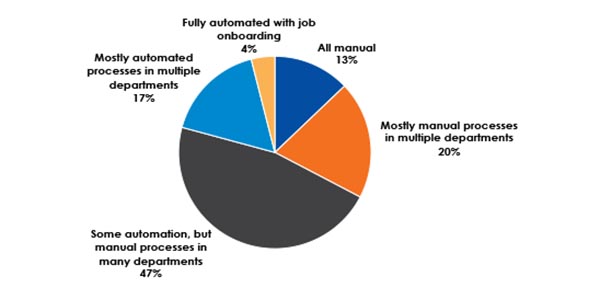- Platforms are enabling universal workflows by offering app marketplaces where best-in-class software can be added for specific functionality, like advanced imposition.
- Most printers have manual processes or islands of automation at best. The industry needs platforms that provide app-like convenience and utility, making it possible to use some or all of the app’s functionality upon download.
- Print workflow platforms could address many of the current struggles that PSPs face when trying to implement and automate their operations.
By Ryan McAbee
Introduction
The printing industry is at the dawn of the platform race. The first platforms appeared over four years ago and have steadily increased their performance, functionality, and partnerships over time to become viable workflow solutions that rival—if not surpass—their predecessors. More vendors are likely to embrace, develop, and launch their ownplatform strategies and initiatives to coincide with the drupa tradeshow in 2020.
Characteristics of True Print Workflow Platforms
A software platform is a complete software development environment and framework where developers can create additional applications that extend the utility of the base. Perhaps a better (and certainly less geeky) way to think about platforms for print is to view them as a base layer that can be builtupon. Many software solutions could be categorized as platforms based on this broad definition, but true print workflow platforms have five common characteristics:
- A common, technical framework to support third-party development and applications: The platform typically provides common software elements, such as the user interface, rules for the user experience, and methods for data exchange.
- Structure and open integration methods: The platform must have a commonframework that defines methods of communication with other data and software solutions. APIs are increasingly the communication of choice within the print industry and platforms. Unlike industry-specific integrations methods like JDF, the use of APIs is standard across all types of software development. As a result, the industry can more readily find and hire programmers.
- The ability to process most files regardless of the anticipated output (e.g., a Universal Workflow): Printers continue to add applications and diversify their print technologies. Gone are the days when a separate workflow was required for each type of printing; now it’s all about the universal workflow that can handle any type of Platforms are enabling universal workflows by offering app marketplaces where best-in-class software can be addedfor specific functionality, like advanced imposition.
- Leverages data to automate tasks and dynamic routing of files: Platforms efficiently use the customer’s intent and metadata to automate downstream workflow tasks and for dynamic routing of those files. For example, if the customer requests a postcard with a foil embellishment, the workflow platform would verify the size (6”x9”) and colorseparations (CMYK + foil channel) to route the job to the appropriate preflighting, batching, and ganging steps before printing.
- On-demand scalability: Platforms must be able to scale based on the peak demand conditions of the printer’s workload. Increasingly, this scalability is executed in the cloud using services like Amazon Web Services or Microsoft Azure, and the process is completely behind-the-scenes to end-users.
Platforms Benefit Print Production
According to Keypoint Intelligence – InfoTrends’ most recent software investment survey, most print service providers (PSPs) in North America have manual processes or islands of automation at best. The industry needs platforms that provide app-like convenience and utility, meaning that some or all of the app’s functionality can be used upon download.
How would you describe your current level of workflow automation?

N = 101 Total Respondents in North America
Source: North American Software Investment Outlook; Keypoint Intelligence – InfoTrends 2018
InfoTrends’ research confirms that integration challenges are a key barrier to workflow automation. When respondents were asked why they had not automated more of their workflow processes, they most commonly cited the technical difficulty and costs associated with integration. Print workflow platforms could address many of the current struggles that PSPs face when trying to implement and automate their operations by:
- Reducing the amount of time it takes to research and identify compatible solutions
- Extending the core workflow through apps that provide application- or technology-specific functionality, thereby eliminating the need for multiple workflows
- Providing a minimal level of expected integration between the platform and marketplace apps[1]
- Reducing the time and cost for advanced integrations with a common framework and API/SDK
- Scaling performance up and down based on volume/throughput (if SaaS)
- Providing an equipment-agnostic workflow
- Enabling a unified data source for business intelligence and analytics
- Leveraging the streams of collected data, in a crowdsourced fashion, to enable software learning—much like machine learning but used to configure and continuously improve software
The Bottom Line
The days of single, monolithic end-to-end workflows are over. Consumers are purchasing print differently than in years past, and printers are in a constant chase to uncover the next value-added application so they can remain profitable. This race translates into more applications, more equipment, and an increase in the number of orders.
Today and in the future, PSPs need a single workflow platform that is flexible, scalable, and interoperable with their existing software and equipment mix. Savvy PSPs have already constructed platforms from best-in-class components, and others within the industry are starting to take notice. Moving forward, printers will not be expecting a bundle of software to automate their workflows. Instead, they will start asking, do you have a platform or an app for that?
Ryan McAbee is a Director for Keypoint Intelligence – InfoTrends' Production Workflow Consulting Service, which focuses on providing technology, business, and market insights to clients in the Digital Marketing & Media and Production Workflow markets. In this role, he is responsible for conducting market research, market analysis and forecasting, content development, industry training, and consulting with print service providers.
[1]Print workflow platforms need to be more proactive in this area.










Discussion
Join the discussion Sign In or Become a Member, doing so is simple and free